The Cambridge History of Japan, Vol. 4: Early Modern Japan
Подождите немного. Документ загружается.

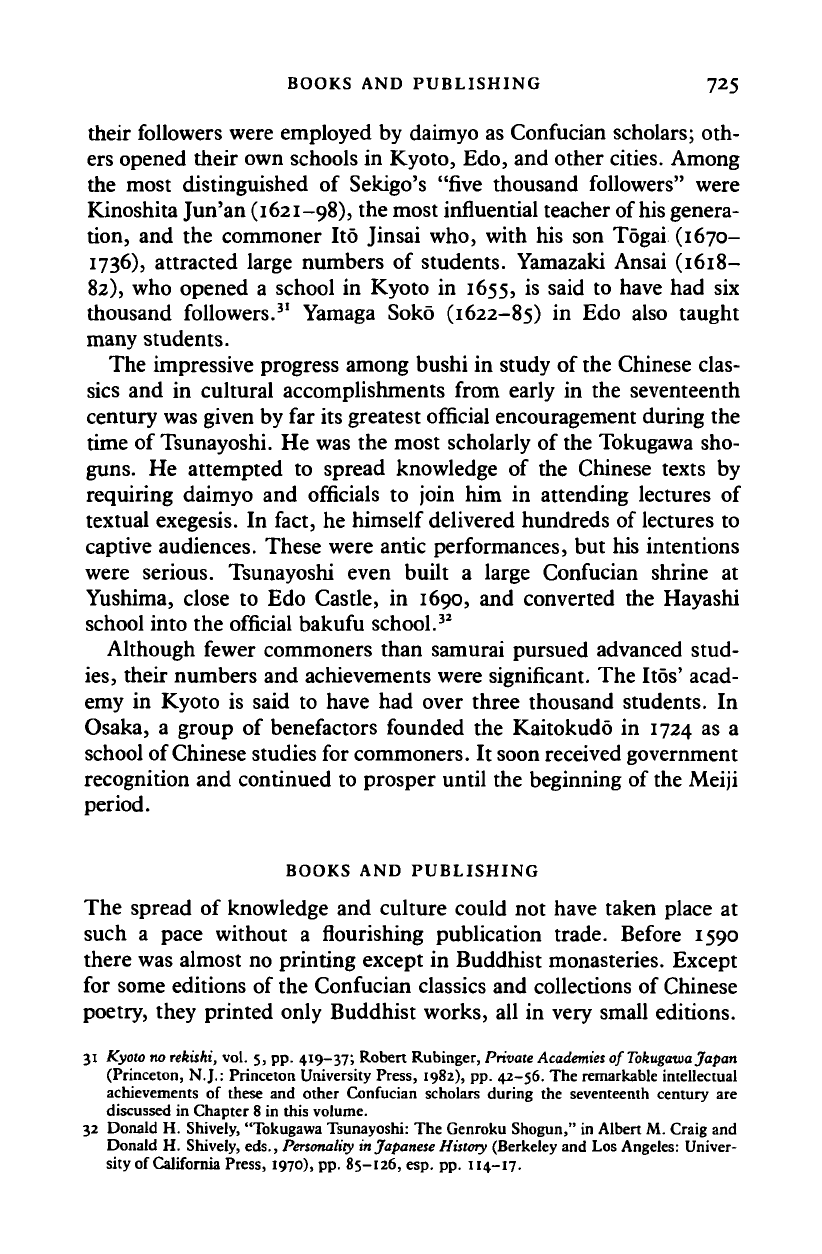
BOOKS AND PUBLISHING 725
their followers were employed by daimyo as Confucian scholars; oth-
ers opened their own schools in Kyoto, Edo, and other cities. Among
the most distinguished of Sekigo's "five thousand followers" were
Kinoshita Jun'an (1621-98), the most influential teacher of his genera-
tion, and the commoner I to Jinsai who, with his son Togai (1670-
1736),
attracted large numbers of students. Yamazaki Ansai (1618-
82),
who opened a school in Kyoto in 1655, is said to have had six
thousand followers.
31
Yamaga Soko (1622-85) in Edo also taught
many students.
The impressive progress among bushi in study of the Chinese clas-
sics and in cultural accomplishments from early in the seventeenth
century was given by far its greatest official encouragement during the
time of Tsunayoshi. He was the most scholarly of the Tokugawa sho-
guns.
He attempted to spread knowledge of the Chinese texts by
requiring daimyo and officials to join him in attending lectures of
textual exegesis. In fact, he himself delivered hundreds of lectures to
captive audiences. These were antic performances, but his intentions
were serious. Tsunayoshi even built a large Confucian shrine at
Yushima, close to Edo Castle, in 1690, and converted the Hayashi
school into the official bakufu school.
32
Although fewer commoners than samurai pursued advanced stud-
ies,
their numbers and achievements were significant. The Itos' acad-
emy in Kyoto is said to have had over three thousand students. In
Osaka, a group of benefactors founded the Kaitokudo in 1724 as a
school of Chinese studies for commoners. It soon received government
recognition and continued to prosper until the beginning of the Meiji
period.
BOOKS AND PUBLISHING
The spread of knowledge and culture could not have taken place at
such a pace without a flourishing publication trade. Before 1590
there was almost no printing except in Buddhist monasteries. Except
for some editions of the Confucian classics and collections of Chinese
poetry, they printed only Buddhist works, all in very small editions.
31 Kyoto no
rekishi,
vol. 5, pp. 419-37; Robert Rubinger, Private
Academies
of Tokugawa Japan
(Princeton, N.J.: Princeton University Press, 1982), pp. 42-56. The remarkable intellectual
achievements of these and other Confucian scholars during the seventeenth century are
discussed in Chapter 8 in this volume.
32 Donald H. Shively, "Tokugawa Tsunayoshi: The Genroku Shogun," in Albert M. Craig and
Donald H. Shively, eds., Personality
in
Japanese History (Berkeley and Los Angeles: Univer-
sity of California Press, 1970), pp. 85-126, esp. pp. 114-17.
Cambridge Histories Online © Cambridge University Press, 2008
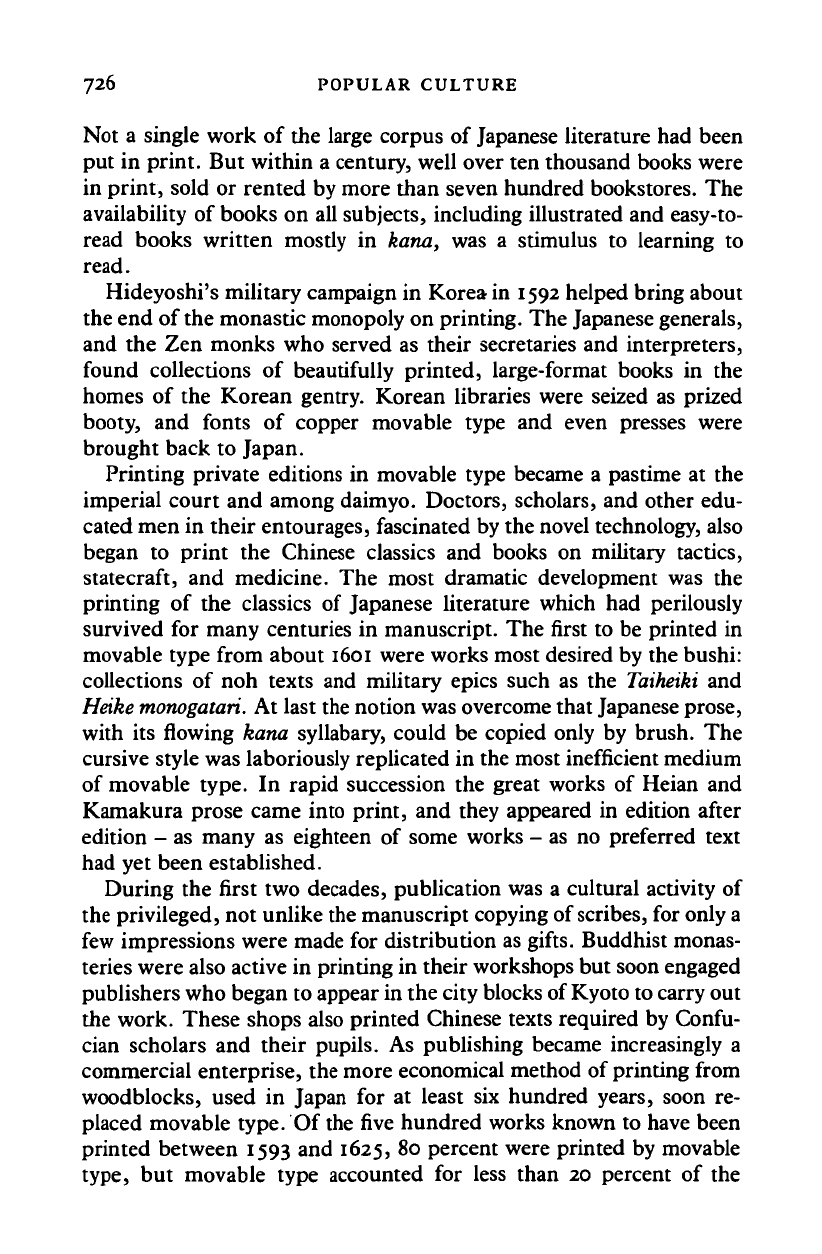
726 POPULAR CULTURE
Not a single work of the large corpus of Japanese literature had been
put in print. But within a century, well over ten thousand books were
in print, sold or rented by more than seven hundred bookstores. The
availability of books on all subjects, including illustrated and easy-to-
read books written mostly in kana, was a stimulus to learning to
read.
Hideyoshi's military campaign in Korea in 1592 helped bring about
the end of the monastic monopoly on printing. The Japanese generals,
and the Zen monks who served as their secretaries and interpreters,
found collections of beautifully printed, large-format books in the
homes of the Korean gentry. Korean libraries were seized as prized
booty, and fonts of copper movable type and even presses were
brought back to Japan.
Printing private editions in movable type became a pastime at the
imperial court and among daimyo. Doctors, scholars, and other edu-
cated men in their entourages, fascinated by the novel technology, also
began to print the Chinese classics and books on military tactics,
statecraft, and medicine. The most dramatic development was the
printing of the classics of Japanese literature which had perilously
survived for many centuries in manuscript. The first to be printed in
movable type from about 1601 were works most desired by the bushi:
collections of noh texts and military epics such as the
Taiheiki
and
Heike
monogatari.
At last the notion was overcome that Japanese prose,
with its flowing kana syllabary, could be copied only by brush. The
cursive style was laboriously replicated in the most inefficient medium
of movable type. In rapid succession the great works of Heian and
Kamakura prose came into print, and they appeared in edition after
edition - as many as eighteen of some works - as no preferred text
had yet been established.
During the first two decades, publication was a cultural activity of
the privileged, not unlike the manuscript copying of
scribes,
for only a
few impressions were made for distribution as gifts. Buddhist monas-
teries were also active in printing in their workshops but soon engaged
publishers who began to appear in the city blocks of Kyoto to carry out
the work. These shops also printed Chinese texts required by Confu-
cian scholars and their pupils. As publishing became increasingly a
commercial enterprise, the more economical method of printing from
woodblocks, used in Japan for at least six hundred years, soon re-
placed movable type. Of the five hundred works known to have been
printed between 1593 and 1625, 80 percent were printed by movable
type,
but movable type accounted for less than 20 percent of the
Cambridge Histories Online © Cambridge University Press, 2008
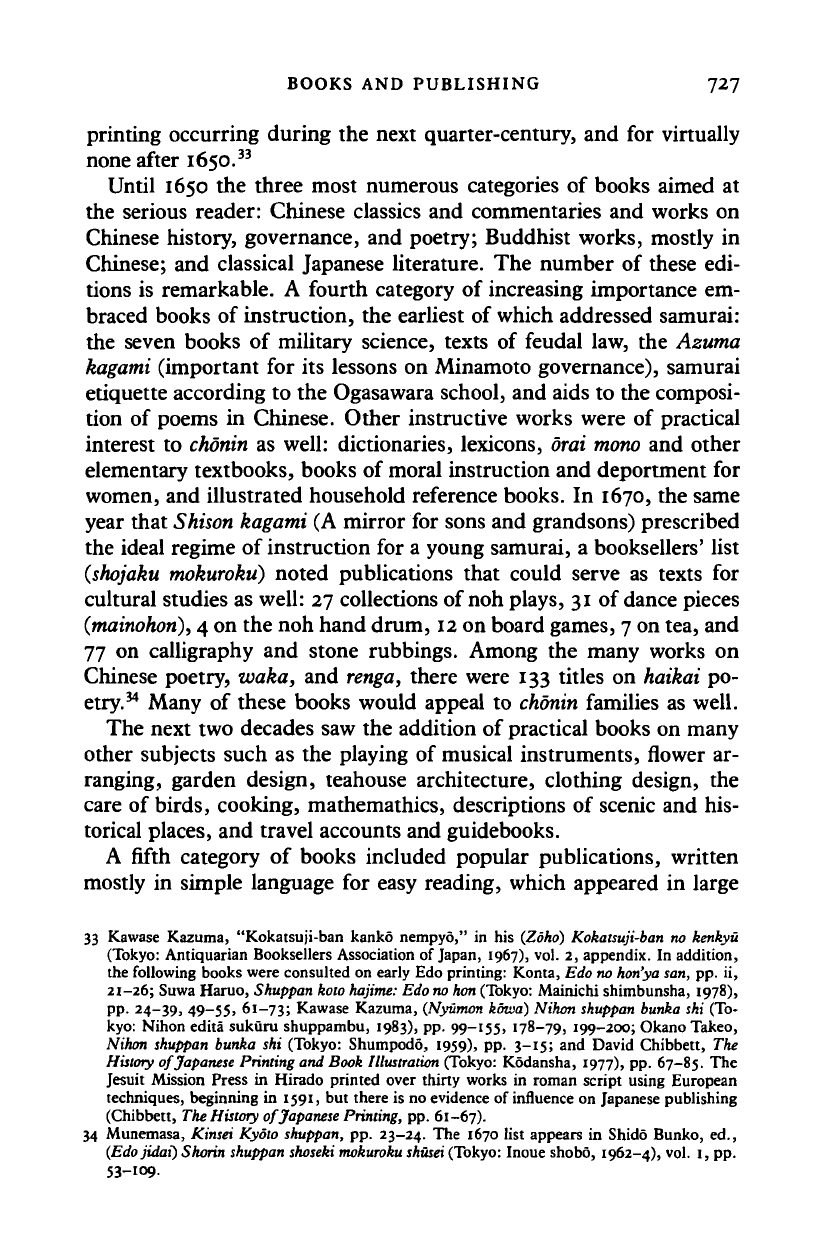
BOOKS AND PUBLISHING 727
printing occurring during the next quarter-century, and for virtually
none after 1650.
33
Until 1650 the three most numerous categories of books aimed at
the serious reader: Chinese classics and commentaries and works on
Chinese history, governance, and poetry; Buddhist works, mostly in
Chinese; and classical Japanese literature. The number of these edi-
tions is remarkable. A fourth category of increasing importance em-
braced books of instruction, the earliest of which addressed samurai:
the seven books of military science, texts of feudal law, the Azuma
kagami
(important for its lessons on Minamoto governance), samurai
etiquette according to the Ogasawara school, and aids to the composi-
tion of poems in Chinese. Other instructive works were of practical
interest to
chonin
as well: dictionaries, lexicons,
drai mono
and other
elementary textbooks, books of moral instruction and deportment for
women, and illustrated household reference books. In 1670, the same
year that
Shison kagami
(A mirror for sons and grandsons) prescribed
the ideal regime of instruction for a young samurai, a booksellers' list
(shojaku mokuroku)
noted publications that could serve as texts for
cultural studies as well: 27 collections of noh plays, 31 of dance pieces
(mainohon),
4 on the noh hand drum,
12
on board games, 7 on tea, and
77 on calligraphy and stone rubbings. Among the many works on
Chinese poetry, waka, and
renga,
there were 133 titles on haikai po-
etry.
34
Many of these books would appeal to
chonin
families as well.
The next two decades saw the addition of practical books on many
other subjects such as the playing of musical instruments, flower ar-
ranging, garden design, teahouse architecture, clothing design, the
care of birds, cooking, mathemathics, descriptions of scenic and his-
torical places, and travel accounts and guidebooks.
A fifth category of books included popular publications, written
mostly in simple language for easy reading, which appeared in large
33 Kawase Kazuma, "Kokatsuji-ban kanko nempyo," in his (Zoho) Kokatsuji-ban no kenkyu
(Tokyo: Antiquarian Booksellers Association of Japan, 1967), vol. 2, appendix. In addition,
the following books were consulted on early Edo printing: Konta, Edo no
hon'ya
san, pp. ii,
21-26; Suwa Haruo, Shuppan koto
hajime:
Edo
no hon
(Tokyo: Mainichi shimbunsha, 1978),
pp.
24-39, 49-55, 61-73; Kawase Kazuma, (Nyiimon kowa) Nihon shuppan bunka shi (To-
kyo:
Nihon edita sukuru shuppambu, 1983), pp. 99-155, 178-79, 199-200; Okano Takeo,
Nihon shuppan bunka shi (Tokyo: Shumpodo, 1959), pp. 3-15; and David Chibbett, The
History of Japanese Printing and Book Illustration (Tokyo: Kodansha, 1977), pp. 67-85. The
Jesuit Mission Press in Hirado printed over thirty works in roman script using European
techniques, beginning in 1591, but there is no evidence of influence on Japanese publishing
(Chibbett, The History of Japanese Printing, pp. 61-67).
34 Munemasa, Kinsei Kyoto shuppan, pp. 23-24. The 1670 list appears in Shido Bunko, ed.,
(Edojidai) Shorin shuppan
shoseki mokuroku shusei
(Tokyo: Inoue shobo, 1962-4), vol. 1, pp.
53-109.
Cambridge Histories Online © Cambridge University Press, 2008
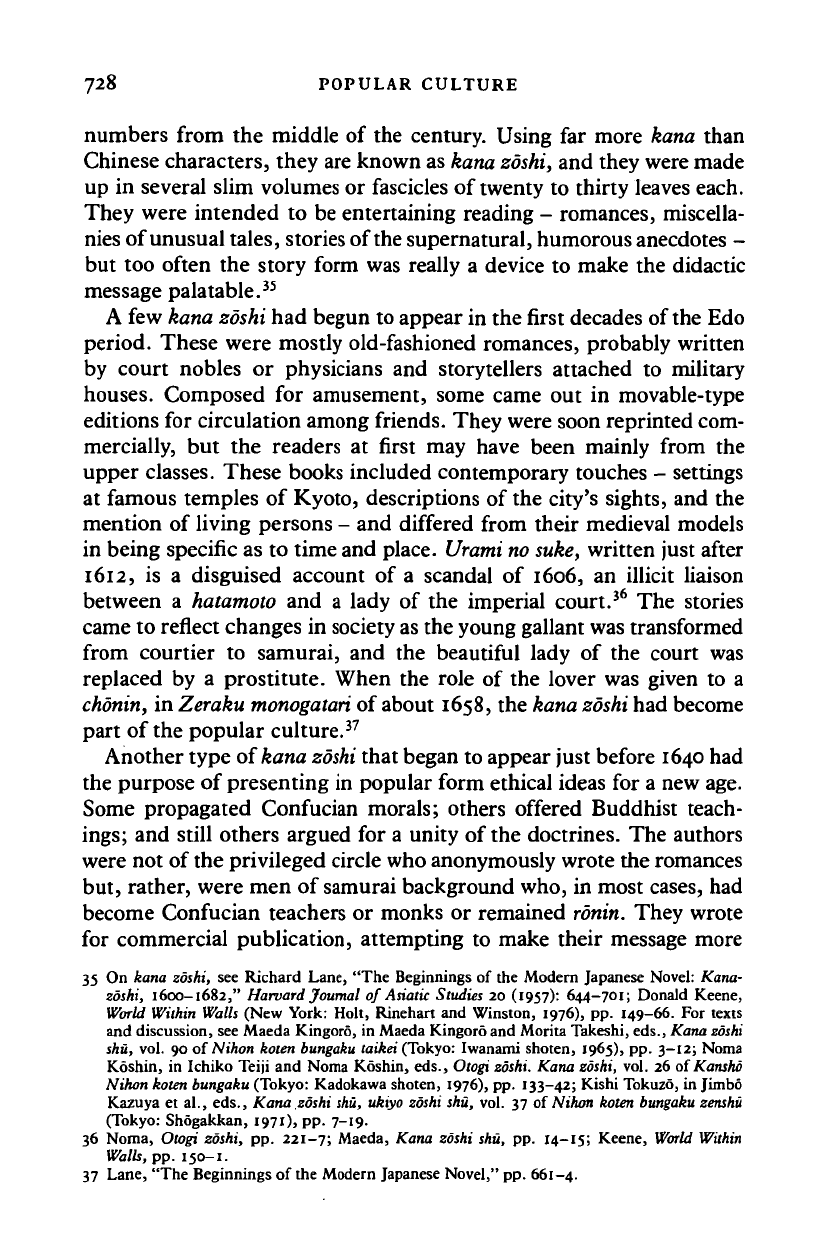
728 POPULAR CULTURE
numbers from the middle of the century. Using far more kana than
Chinese characters, they are known as
kana
zoshi,
and they were made
up in several slim volumes or fascicles of twenty to thirty leaves each.
They were intended to be entertaining reading - romances, miscella-
nies of unusual tales, stories of the supernatural, humorous anecdotes -
but too often the story form was really a device to make the didactic
message palatable.
35
A few kana
zoshi
had begun to appear in the first decades of the Edo
period. These were mostly old-fashioned romances, probably written
by court nobles or physicians and storytellers attached to military
houses. Composed for amusement, some came out in movable-type
editions for circulation among friends. They were soon reprinted com-
mercially, but the readers at first may have been mainly from the
upper classes. These books included contemporary touches - settings
at famous temples of Kyoto, descriptions of the city's sights, and the
mention of living persons - and differed from their medieval models
in being specific as to time and place.
Urami no
suke,
written just after
1612,
is a disguised account of a scandal of 1606, an illicit liaison
between a hatamoto and a lady of the imperial court.
36
The stories
came to reflect changes in society as the young gallant was transformed
from courtier to samurai, and the beautiful lady of the court was
replaced by a prostitute. When the role of the lover was given to a
chonin,
in Zeraku
monogatari
of about 1658, the
kana zoshi
had become
part of the popular culture.
37
Another type of kana
zoshi
that began to appear just before 1640 had
the purpose of presenting in popular form ethical ideas for a new age.
Some propagated Confucian morals; others offered Buddhist teach-
ings;
and still others argued for a unity of the doctrines. The authors
were not of the privileged circle who anonymously wrote the romances
but, rather, were men of samurai background who, in most cases, had
become Confucian teachers or monks or remained
rbnin.
They wrote
for commercial publication, attempting to make their message more
35 On kana zoshi, see Richard Lane, "The Beginnings of the Modern Japanese Novel: Kana-
zoshi, 1600-1682," Harvard Journal of Asiatic Studies 20 (1957): 644-701; Donald Keene,
World Within Walls (New York: Holt, Rinehart and Winston, 1976), pp. 149-66. For texts
and discussion, see Maeda Kingoro, in Maeda Kingoro and Morita Takeshi, eds., Kana
zoshi
shu,
vol. 90 of Nihon koten
bungaku
taikei (Tokyo: Iwanami shoten, 1965), pp. 3-12; Noma
Koshin, in Ichiko Teiji and Noma Koshin, eds., Otogi zoshi. Kana zoshi, vol. 26 of
Kansho
Nihon koten bungaku (Tokyo: Kadokawa shoten, 1976), pp. 133-42; Kishi Tokuzo, in Jimbo
Kazuya et al., eds., Kana,zoshi
shu,
ukiyo zoshi shu, vol. 37 of Nihon koten
bungaku zenshu
(Tokyo: Shogakkan, 1971), pp. 7-19.
36 Noma, Otogi zoshi, pp. 221-7; Maeda, Kana zoshi shu, pp. 14-15; Keene, World Within
Walls, pp.
150-1.
37 Lane, "The Beginnings of the Modern Japanese Novel," pp. 661-4.
Cambridge Histories Online © Cambridge University Press, 2008
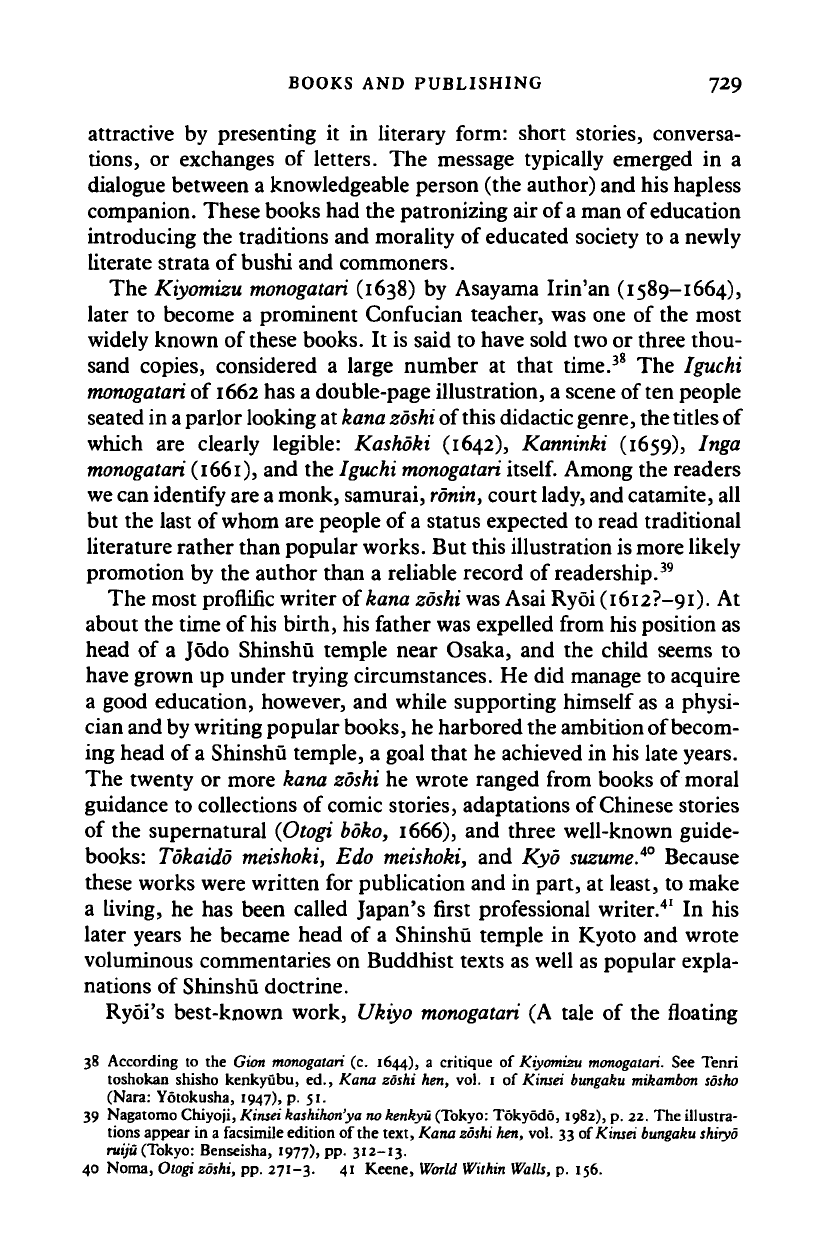
BOOKS AND PUBLISHING 729
attractive by presenting it in literary form: short stories, conversa-
tions,
or exchanges of letters. The message typically emerged in a
dialogue between a knowledgeable person (the author) and his hapless
companion. These books had the patronizing air of a man of education
introducing the traditions and morality of educated society to a newly
literate strata of bushi and commoners.
The Kiyomizu
monogatari
(1638) by Asayama Irin'an (1589-1664),
later to become a prominent Confucian teacher, was one of the most
widely known of these books. It is said to have sold two or three thou-
sand copies, considered a large number at that time.
38
The Iguchi
monogatari
of
1662
has a double-page illustration, a scene of ten people
seated in
a
parlor looking at kana
zoshi
of this didactic
genre,
the titles
of
which are clearly legible: Kashoki (1642), Kanninki (1659), Inga
monogatari
(1661), and the
Iguchi monogatari
itself.
Among the readers
we
can identify are
a
monk, samurai,
ronin,
court
lady,
and catamite, all
but the last of whom are people of
a
status expected to read traditional
literature rather than popular
works.
But this illustration is more likely
promotion by the author than a reliable record of readership.
39
The most proflific writer of
kana zoshi
was Asai Ryoi (i6i2?-9i). At
about the time of his birth, his father was expelled from his position as
head of a Jodo Shinshu temple near Osaka, and the child seems to
have grown up under trying circumstances. He did manage to acquire
a good education, however, and while supporting himself as a physi-
cian and by writing popular
books,
he harbored the ambition of becom-
ing head of
a
Shinshu temple, a goal that he achieved in his late years.
The twenty or more kana
zoshi
he wrote ranged from books of moral
guidance to collections of comic stories, adaptations of Chinese stories
of the supernatural
(Otogi
boko,
1666), and three well-known guide-
books: Tokaido meishoki, Edo meishoki, and Kyo suzume.*
0
Because
these works were written for publication and in part, at least, to make
a living, he has been called Japan's first professional writer.
41
In his
later years he became head of a Shinshu temple in Kyoto and wrote
voluminous commentaries on Buddhist texts as well as popular expla-
nations of Shinshu doctrine.
Ryoi's best-known work, Ukiyo
monogatari
(A tale of the floating
38 According to the Gion monogatari (c. 1644), a critique of Kiyomizu monogatari. See Tenri
toshokan shisho kenkyubu, ed., Kana zoshi hen, vol. 1 of Kinsei bungaku mikambon sosho
(Nara: Yotokusha, 1947), p. 51.
39 Nagatomo Chiyoji, Kinsei
kashihon'ya no kenkyu
(Tokyo: Tdkyodo, 1982), p. 22. The illustra-
tions appear in a facsimile edition of the text, Kana zoshi
hen,
vol. 33 of Kinsei
bungaku
shiryo
ruiju
(Tokyo: Benseisha, 1977), pp. 312-13.
40 Noma, Otogi zoshi, pp. 271-3. 41 Keene,
World
Within Walls, p. 156.
Cambridge Histories Online © Cambridge University Press, 2008
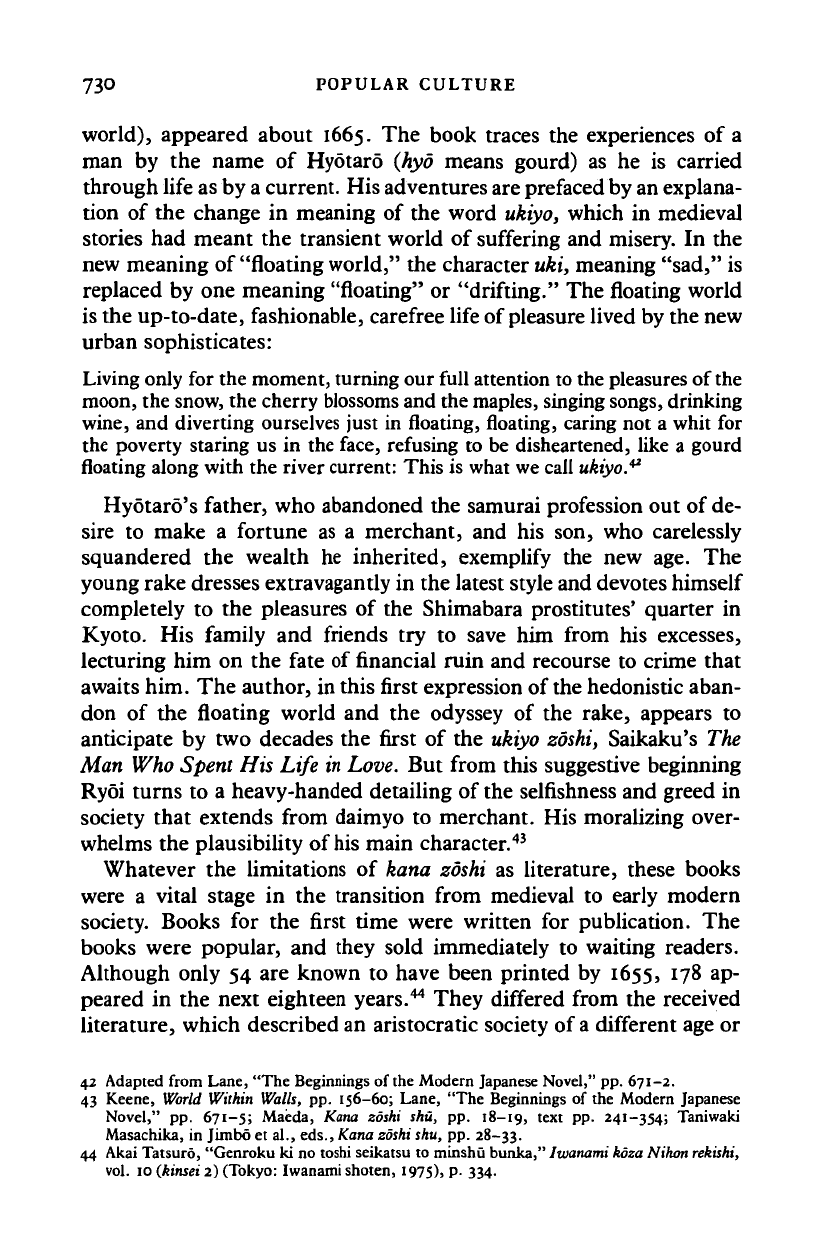
73O POPULAR CULTURE
world),
appeared about 1665. The book traces the experiences of a
man by the name of Hyotaro (hyd means gourd) as he is carried
through life as by a current. His adventures are prefaced by an explana-
tion of the change in meaning of the word ukiyo, which in medieval
stories had meant the transient world of suffering and misery. In the
new meaning of "floating world," the character uki, meaning "sad," is
replaced by one meaning "floating" or "drifting." The floating world
is the up-to-date, fashionable, carefree life of pleasure lived by the new
urban sophisticates:
Living only for the moment, turning our full attention to the pleasures of
the
moon, the
snow,
the cherry blossoms and the
maples,
singing
songs,
drinking
wine, and diverting ourselves just in floating, floating, caring not a whit for
the poverty staring us in the face, refusing to be disheartened, like a gourd
floating along with the river
current:
This is what
we
call
ukiyo.*
2
Hyotaro's father, who abandoned the samurai profession out of de-
sire to make a fortune as a merchant, and his son, who carelessly
squandered the wealth he inherited, exemplify the new age. The
young rake dresses extravagantly in the latest style and devotes himself
completely to the pleasures of the Shimabara prostitutes' quarter in
Kyoto. His family and friends try to save him from his excesses,
lecturing him on the fate of financial ruin and recourse to crime that
awaits him. The author, in this first expression of
the
hedonistic aban-
don of the floating world and the odyssey of the rake, appears to
anticipate by two decades the first of the ukiyo zoshi, Saikaku's The
Man Who Spent His Life
in
Love. But from this suggestive beginning
Ryoi turns to a heavy-handed detailing of the selfishness and greed in
society that extends from daimyo to merchant. His moralizing over-
whelms the plausibility of
his
main character.
43
Whatever the limitations of kana zoshi as literature, these books
were a vital stage in the transition from medieval to early modern
society. Books for the first time were written for publication. The
books were popular, and they sold immediately to waiting readers.
Although only 54 are known to have been printed by 1655, 178 ap-
peared in the next eighteen years.
44
They differed from the received
literature, which described an aristocratic society of
a
different age or
42 Adapted from Lane, "The Beginnings of
the
Modern Japanese Novel," pp. 671-2.
43 Keene,
World
Within Walls, pp. 156-60; Lane, "The Beginnings of the Modern Japanese
Novel," pp. 671-5; Maeda, Kana zoshi shu, pp. 18-19,
text
PP- 241—354; Taniwaki
Masachika, in Jimbo et al., eds.,
Kana zoshi
shu,
pp.
28-33.
44 Akai Tatsuro, "Genroku ki no tosbi seikatsu to minshu bunka,"
Iwanami koza Nikon
rekishi,
vol.
10
(Jkinsei
2) (Tokyo: Iwanami shoten, 1975), p. 334.
Cambridge Histories Online © Cambridge University Press, 2008
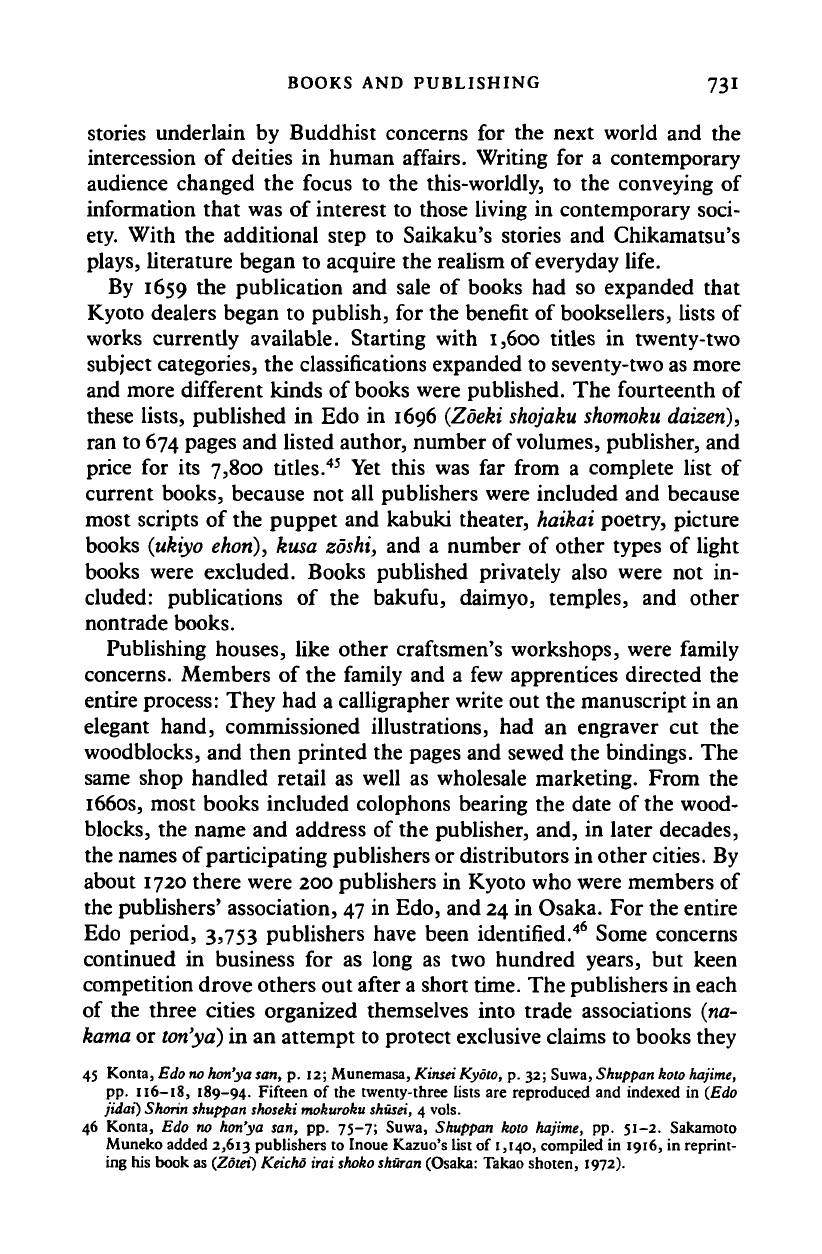
BOOKS AND PUBLISHING 73I
stories underlain by Buddhist concerns for the next world and the
intercession of deities in human affairs. Writing for a contemporary
audience changed the focus to the this-worldly, to the conveying of
information that was of interest to those living in contemporary soci-
ety. With the additional step to Saikaku's stories and Chikamatsu's
plays,
literature began to acquire the realism of everyday life.
By 1659 the publication and sale of books had so expanded that
Kyoto dealers began to publish, for the benefit of booksellers, lists of
works currently available. Starting with 1,600 titles in twenty-two
subject categories, the classifications expanded to seventy-two as more
and more different kinds of books were published. The fourteenth of
these lists, published in Edo in 1696 (Zdeki
shojaku shomoku
daizeri),
ran to 674 pages and listed author, number of
volumes,
publisher, and
price for its 7,800 titles.
45
Yet this was far from a complete list of
current books, because not all publishers were included and because
most scripts of the puppet and kabuki theater, haikai poetry, picture
books (ukiyo
ehori),
kusa zoshi, and a number of other types of light
books were excluded. Books published privately also were not in-
cluded: publications of the bakufu, daimyo, temples, and other
nontrade books.
Publishing houses, like other craftsmen's workshops, were family
concerns. Members of the family and a few apprentices directed the
entire process: They had a calligrapher write out the manuscript in an
elegant hand, commissioned illustrations, had an engraver cut the
woodblocks, and then printed the pages and sewed the bindings. The
same shop handled retail as well as wholesale marketing. From the
1660s, most books included colophons bearing the date of the wood-
blocks, the name and address of the publisher, and, in later decades,
the names of participating publishers or distributors in other
cities.
By
about 1720 there were 200 publishers in Kyoto who were members of
the publishers' association, 47 in Edo, and 24 in Osaka. For the entire
Edo period, 3,753 publishers have been identified.
46
Some concerns
continued in business for as long as two hundred years, but keen
competition drove others out after a short time. The publishers in each
of the three cities organized themselves into trade associations (na-
katna
or
ton'ya)
in an attempt to protect exclusive claims to books they
45 Konta, Edo
no
hon'ya san, p. 12; Munemasa, Kinsei Kyoto, p. 32; Suwa, Shuppan koto hajime,
pp.
116-18, 189-94. Fifteen of the twenty-three lists are reproduced and indexed in {Edo
jiiai)
Shorin shuppan shoseki mokuroku
shusei,
4 vols.
46 Konta, Edo no hon'ya san, pp. 75-7; Suwa, Shuppan koto hajime, pp. 51-2. Sakamoto
Muneko added 2,613 publishers to Inoue Kazuo's list of 1,140, compiled in 1916, in reprint-
ing his book as
{Zolex)
Keicho irai
shoko shuran
(Osaka: Takao shoten, 1972).
Cambridge Histories Online © Cambridge University Press, 2008
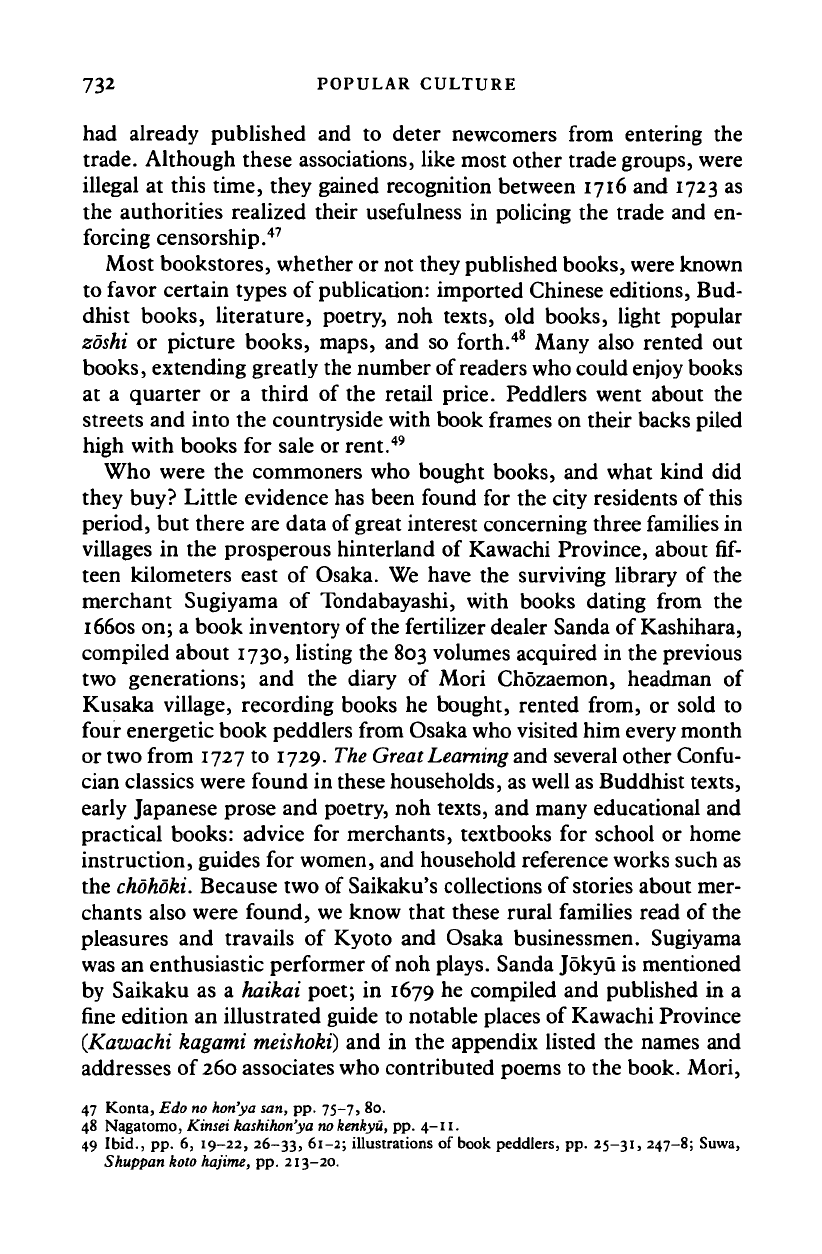
732 POPULAR CULTURE
had already published
and to
deter newcomers from entering
the
trade. Although these associations, like most other trade groups, were
illegal
at
this time, they gained recognition between 1716
and
1723
as
the authorities realized their usefulness
in
policing
the
trade
and en-
forcing censorship.
47
Most bookstores, whether
or
not they published books, were known
to favor certain types
of
publication: imported Chinese editions,
Bud-
dhist books, literature, poetry,
noh
texts,
old
books, light popular
zoshi
or
picture books, maps,
and so
forth.
48
Many also rented
out
books, extending greatly the number of readers who could enjoy books
at
a
quarter
or a
third
of the
retail price. Peddlers went about
the
streets
and
into
the
countryside with book frames
on
their backs piled
high with books
for
sale or rent.
49
Who were
the
commoners
who
bought books,
and
what kind
did
they buy? Little evidence has been found
for the
city residents
of
this
period,
but
there
are
data of great interest concerning three families
in
villages
in the
prosperous hinterland
of
Kawachi Province, about
fif-
teen kilometers east
of
Osaka.
We
have
the
surviving library
of the
merchant Sugiyama
of
Tondabayashi, with books dating from
the
1660s on;
a
book inventory
of
the
fertilizer dealer Sanda
of
Kashihara,
compiled about 1730, listing
the
803 volumes acquired
in
the previous
two generations;
and the
diary
of
Mori Chozaemon, headman
of
Kusaka village, recording books
he
bought, rented from,
or
sold
to
four energetic book peddlers from Osaka who visited him every month
or two from 1727
to
1729.
The Great Learning
and several other Confu-
cian classics were found
in
these households, as well as Buddhist texts,
early Japanese prose
and
poetry,
noh
texts,
and
many educational
and
practical books: advice
for
merchants, textbooks
for
school
or
home
instruction, guides
for
women,
and
household reference works such as
the
chohoki.
Because two
of
Saikaku's collections
of
stories about mer-
chants also were found, we know that these rural families read
of
the
pleasures
and
travails
of
Kyoto
and
Osaka businessmen. Sugiyama
was
an
enthusiastic performer
of
noh plays. Sanda Jokyu is mentioned
by Saikaku
as a
haikai poet;
in
1679
he
compiled
and
published
in a
fine edition
an
illustrated guide
to
notable places
of
Kawachi Province
{Kawachi
kagami
meishoki)
and in the
appendix listed
the
names
and
addresses
of
260
associates who contributed poems
to the
book. Mori,
47 Konta, Edo no hon'ya san, pp. 75-7, 80.
48 Nagatomo, Kinsei kashihon'ya
no
kenkyu, pp. 4-11.
49 Ibid., pp. 6, 19-22,
26-33,
61-2; illustrations of book peddlers, pp.
25-31,
247-8; Suwa,
Shuppan
koto
hajime,
pp. 213-20.
Cambridge Histories Online © Cambridge University Press, 2008
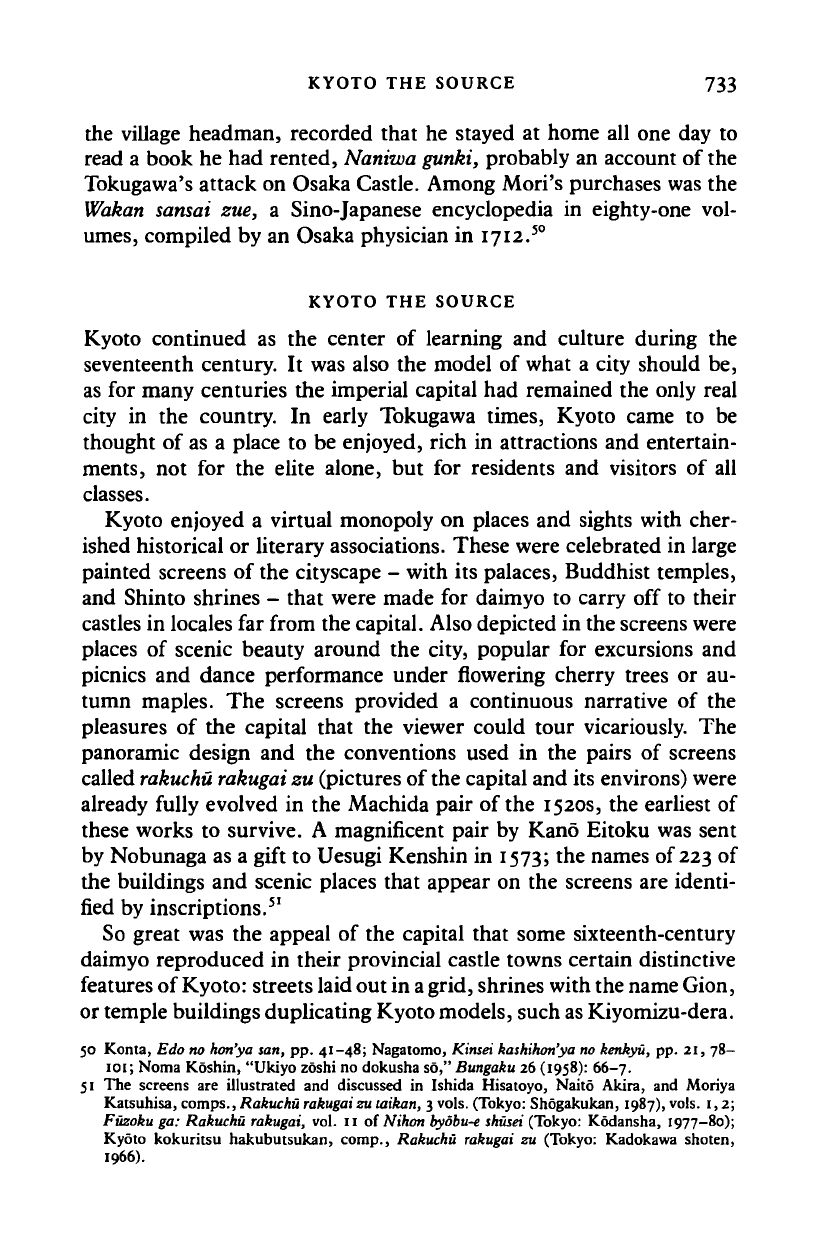
KYOTO THE SOURCE 733
the village headman, recorded that he stayed at home all one day to
read a book he had rented, Naniwa
gunki,
probably an account of the
Tokugawa's attack on Osaka Castle. Among Mori's purchases was the
Wakan sansai zue, a Sino-Japanese encyclopedia in eighty-one vol-
umes,
compiled by an Osaka physician in 1712.
50
KYOTO THE SOURCE
Kyoto continued as the center of learning and culture during the
seventeenth century. It was also the model of what a city should be,
as for many centuries the imperial capital had remained the only real
city in the country. In early Tokugawa times, Kyoto came to be
thought of as a place to be enjoyed, rich in attractions and entertain-
ments, not for the elite alone, but for residents and visitors of all
classes.
Kyoto enjoyed a virtual monopoly on places and sights with cher-
ished historical or literary associations. These were celebrated in large
painted screens of the cityscape - with its palaces, Buddhist temples,
and Shinto shrines - that were made for daimyo to carry off to their
castles in locales far from the capital. Also depicted in the screens were
places of scenic beauty around the city, popular for excursions and
picnics and dance performance under flowering cherry trees or au-
tumn maples. The screens provided a continuous narrative of the
pleasures of the capital that the viewer could tour vicariously. The
panoramic design and the conventions used in the pairs of screens
called
rakuchu rakugai
zu (pictures of the capital and its environs) were
already fully evolved in the Machida pair of the 1520s, the earliest of
these works to survive. A magnificent pair by Kano Eitoku was sent
by Nobunaga as a gift to Uesugi Kenshin in 1573; the names of
223
of
the buildings and scenic places that appear on the screens are identi-
fied by inscriptions.
51
So great was the appeal of the capital that some sixteenth-century
daimyo reproduced in their provincial castle towns certain distinctive
features of Kyoto: streets laid out in
a
grid, shrines with the name Gion,
or temple buildings duplicating Kyoto
models,
such
as
Kiyomizu-dera.
50 Konta, Edo no hon'ya san, pp. 41-48; Nagatomo, Kinsei
kashihon'ya
no kenkyu, pp. 21, 78—
101;
Noma Koshin, "Ukiyo zoshi no dokusha so," Bungaku 26 (1958): 66-7.
51 The screens are illustrated and discussed in Ishida Hisatoyo, Naito Akira, and Moriya
Katsuhisa, comps., Rakuchu
rakugai
zu taikan, 3 vols. (Tokyo: Shogakukan, 1987), vols. 1,2;
Fuzoku ga: Rakuchu rakugai, vol. 11 of Nihon bydbu-e
shusei
(Tokyo: Kodansha, 1977-80);
Kyoto kokuritsu hakubutsukan, comp., Rakuchu rakugai zu (Tokyo: Kadokawa shoten,
1966).
Cambridge Histories Online © Cambridge University Press, 2008
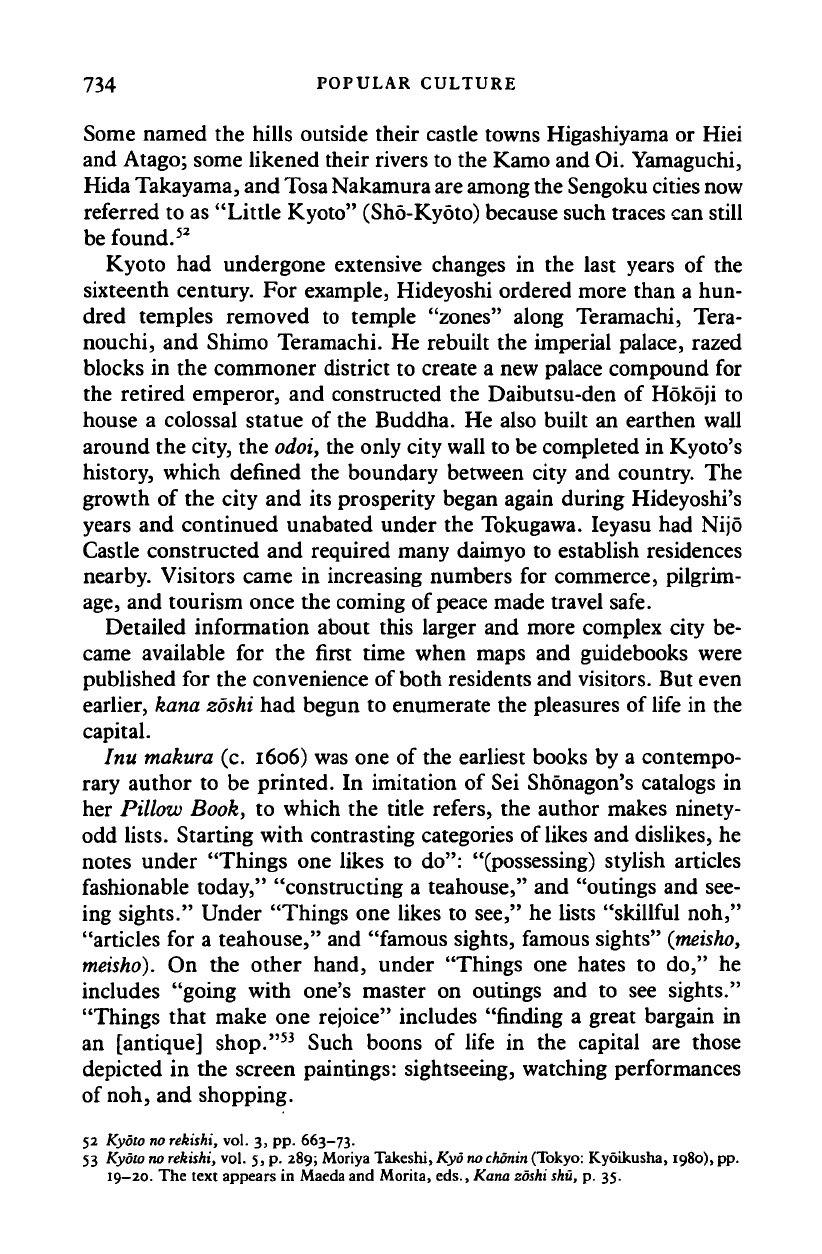
734 POPULAR CULTURE
Some named the hills outside their castle towns Higashiyama or Hiei
and Atago; some likened their rivers to the Kamo and Oi. Yamaguchi,
Hida Takayama, and
Tosa
Nakamura
are
among the Sengoku cities now
referred to as "Little Kyoto" (Sho-Kyoto) because such traces can still
be found.
52
Kyoto had undergone extensive changes in the last years of the
sixteenth century. For example, Hideyoshi ordered more than a hun-
dred temples removed to temple "zones" along Teramachi, Tera-
nouchi, and Shimo Teramachi. He rebuilt the imperial palace, razed
blocks in the commoner district to create a new palace compound for
the retired emperor, and constructed the Daibutsu-den of Hokoji to
house a colossal statue of the Buddha. He also built an earthen wall
around the city, the
odoi,
the only city wall to be completed in Kyoto's
history, which defined the boundary between city and country. The
growth of the city and its prosperity began again during Hideyoshi's
years and continued unabated under the Tokugawa. Ieyasu had Nijo
Castle constructed and required many daimyo to establish residences
nearby. Visitors came in increasing numbers for commerce, pilgrim-
age,
and tourism once the coming of peace made travel safe.
Detailed information about this larger and more complex city be-
came available for the first time when maps and guidebooks were
published for the convenience of both residents and visitors. But even
earlier, kana zoshi had begun to enumerate the pleasures of life in the
capital.
Inu makura (c. 1606) was one of the earliest books by a contempo-
rary author to be printed. In imitation of Sei Shonagon's catalogs in
her Pillow Book, to which the title refers, the author makes ninety-
odd lists. Starting with contrasting categories of likes and dislikes, he
notes under "Things one likes to do": "(possessing) stylish articles
fashionable today," "constructing a teahouse," and "outings and see-
ing sights." Under "Things one likes to see," he lists "skillful noh,"
"articles for a teahouse," and "famous sights, famous sights"
(meisho,
meisho).
On the other hand, under "Things one hates to do," he
includes "going with one's master on outings and to see sights."
"Things that make one rejoice" includes "finding a great bargain in
an [antique] shop."
53
Such boons of life in the capital are those
depicted in the screen paintings: sightseeing, watching performances
of noh, and shopping.
52 Kyoto no rekishi, vol. 3, pp. 663-73.
53 Kyoto
no
rekishi, vol. 5, p. 289; Moriya Takeshi, Kyo
no chonin
(Tokyo:
Kyoikusha, 1980), pp.
19-20.
The text appears in Maeda and Morita, eds., Kana zoshi
shu,
p. 35.
Cambridge Histories Online © Cambridge University Press, 2008
